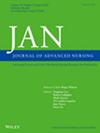实施护士主导的老年患者出院后自我护理信息系统的障碍和促进因素:一项探索性顺序混合方法研究
IF 3.8
3区 医学
Q1 NURSING
引用次数: 0
摘要
目的从护士的角度探讨影响基于电子健康记录的信息系统实施的决定因素及其与基于理论领域框架(TDF)的实施保真度的关系。探索性顺序混合方法设计。方法在第一阶段,对53名有目的选择的护士进行半结构化访谈,通过直接内容分析来探讨影响信息系统实施的TDF领域。在第二阶段,根据定性结果,在482名护士中进行了横断面调查,通过运行广义线性回归模型来确定最相关和相对重要的TDF领域。结果定性访谈产生了13个主要影响因素,包括技术特征、知识、态度、角色认同、自我效能、目标设定、信息流通和护士之间的沟通。定量调查结果显示,70%的护士通过信息系统使用和打印书面表格,只有34%的护士持续提供口头教育。回归分析确定了与实现保真度相关且重要的九个领域,包括知识、技能、角色认同、对结果的信念、对能力的信念、意图、目标、记忆和决策过程,以及环境背景。结论:我们的研究结果证实了之前关于实施数字卫生技术决定因素的证据,包括知识、能力、感知有效性、角色协议、意图、决策过程和环境背景。此外,我们强调了目标设定对于成功实施的重要性。本研究从护士的角度探讨了影响护士主导的急症后护理信息系统成功实施的相对重要的相关因素。这些结果可以指导执业护士实施类似的举措,并支持基于证据的决策。研究人员还可以进一步调查确定的决定因素之间的关系。期刊文章混合方法研究报告标准。病人或公众捐款:没有病人或公众捐款。本文章由计算机程序翻译,如有差异,请以英文原文为准。
Barriers and Facilitators to Implementing a Nurse‐Led Information System for Older Adult Patients' Post‐Discharge Self‐Care: An Exploratory Sequential Mixed‐Methods Study
AimTo explore determinants impacting an Electronic Health Record‐based information system implementation and their association with implementation fidelity based on the Theoretical Domains Framework (TDF) from nurses' perspectives.DesignExploratory sequential mixed‐method design.MethodsIn stage one, semi‐structured interviews with 53 purposively selected nurses informed the exploration of TDF domains influencing the implementation of the information system with directed content analysis. In stage two, a cross‐sectional survey, informed by the qualitative findings, was conducted among 482 nurses to identify the most relevant and relatively important TDF domains by running generalised linear regression models.ResultsThe qualitative interviews generated 13 TDF domains that were identified as major influencing factors, including technology characteristics, knowledge, attitudes, role agreement, self‐efficacy, goal‐setting, information circulation, and communication among nurses. Quantitative findings showed that 70% of nurses used and printed the written form through the information system, and only 34% offered verbal education consistently. Regression analysis identified nine domains that were relevant and important factors for implementation fidelity, including knowledge, skills, role identity, beliefs in consequences, beliefs in capabilities, intentions, goals, memory and decision processes, and environmental context.ConclusionOur findings confirmed previous evidence on determinants of implementing digital health technologies, including knowledge, competencies, perceived effectiveness, role agreement, intentions, decision processes, and environmental context. Additionally, we highlighted the importance of goal‐setting for successful implementation.ImpactThis study investigated the relatively important associated factors that can impact the successful implementation of the nurse‐led information system for post‐acute care based on nurses' perspectives. These results can guide nurse practitioners in implementing similar initiatives and support evidence‐based decision‐making. Researchers can also further investigate the relationships between the identified determinants.Reporting MethodJournal Article Reporting Standards for Mixed Methods Research.Patient or Public ContributionNo patient or public contribution.
求助全文
通过发布文献求助,成功后即可免费获取论文全文。
去求助
来源期刊
CiteScore
6.40
自引率
7.90%
发文量
369
审稿时长
3 months
期刊介绍:
The Journal of Advanced Nursing (JAN) contributes to the advancement of evidence-based nursing, midwifery and healthcare by disseminating high quality research and scholarship of contemporary relevance and with potential to advance knowledge for practice, education, management or policy.
All JAN papers are required to have a sound scientific, evidential, theoretical or philosophical base and to be critical, questioning and scholarly in approach. As an international journal, JAN promotes diversity of research and scholarship in terms of culture, paradigm and healthcare context. For JAN’s worldwide readership, authors are expected to make clear the wider international relevance of their work and to demonstrate sensitivity to cultural considerations and differences.

 求助内容:
求助内容: 应助结果提醒方式:
应助结果提醒方式:


